Thinking about DIY concrete leveling? If so, you’ve landed on the right page because that’s what we’re going to talk about in this article. We’ll go over why concrete slabs, such as sideways, driveways, and patios, become uneven, how concrete leveling works, the two different methods of concrete leveling (including which one is best), whether DIY concrete leveling is a good idea and more.
Why Do Concrete Slabs Become Unlevel?
Concrete slabs become uneven for various reasons, including the following:
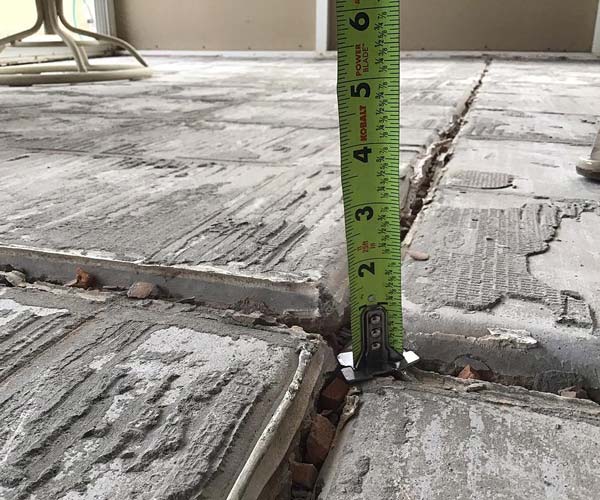
- One of the main culprits behind unlevel concrete is poor installation. If the soil beneath the slab isn’t adequately compacted before pouring the concrete, it can lead to an unstable base that will eventually cause the slab to shift and become uneven.
- If the concrete mix is too wet or not mixed properly, it may not cure correctly, leading to an uneven surface.
- Weather can contribute to uneven concrete as well. When temperatures fluctuate, or there is a freeze-thaw cycle, the concrete may expand or contract, leading to cracks that can cause the slab to become unlevel.
- Additionally, heavy rain or flooding can wash away the soil underneath the slab, leading to voids, instability, and unevenness.
- Traffic can also play a role in unlevel concrete. Over time, the weight of vehicles or foot traffic can cause the concrete to sink or shift, creating an uneven surface that poses risks to safety and mobility.
While concrete slabs are durable, they aren’t invincible. However, with proper installation, maintenance, and repair, concrete slabs can remain level and functional for years.
What Is Concrete Leveling?
Concrete leveling is used to lift and level sunken or uneven concrete slabs such as sidewalks and driveways. This method involves injecting something (a cement slurry or polyurethane foam) beneath the sunken concrete to lift it back to its original position. Concrete leveling restores the safety and appearance of the concrete slab.
Polyurethane Foam Injection Vs. Mudjacking
The two primary ways of leveling an uneven concrete slab are polyurethane foam injection and mudjacking. Mudjacking was once the go-to method for leveling a concrete slab. However, polyurethane foam injection (or polyjacking) is today’s preferred method for leveling an uneven sidewalk, driveway, patio, etc.
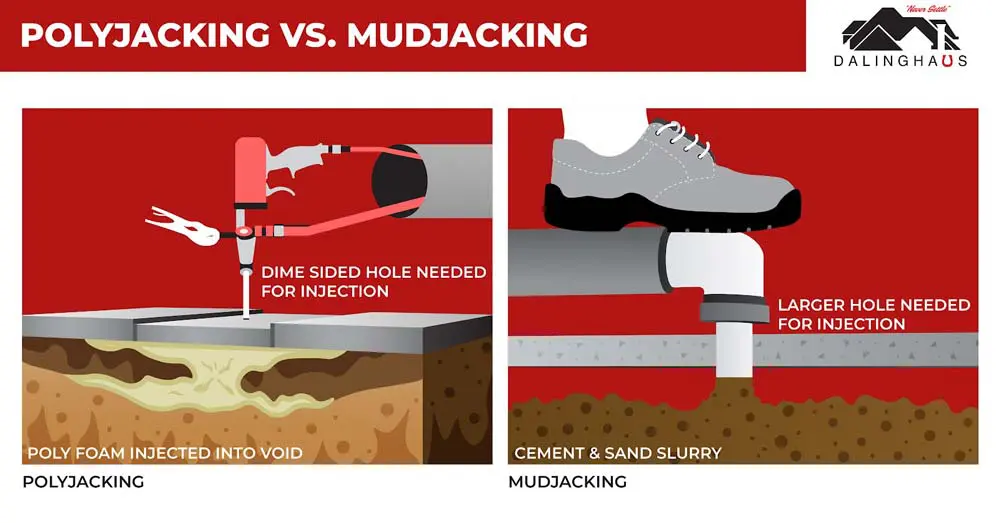
Mudjacking
Mudjacking involves drilling 2-3 inch holes into the affected concrete slab and using them to pump a mixture of water, soil, and cement underneath it. This cement slurry fills voids, raising the slab to its original position.
While mudjacking was once the go-to method of lifting and leveling an unlevel slab, it’s not as popular today because it requires more equipment and is messier than polyurethane foam injection.
Polyurethane Foam Injection
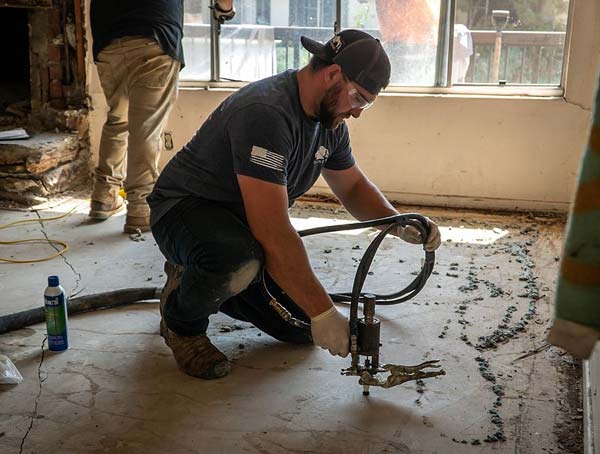
Polyurethane foam injection is a newer, cleaner, and more efficient method of leveling concrete slabs. It involves drilling small, dime-sized holes into the affected slab and injecting a two-part polyurethane foam mixture. The mixture quickly expands to fill voids and lifts the slab back to its original position.
Polyurethane foam injection is ideal for leveling driveways and sidewalks because it’s a lightweight material that can withstand heavy loads and won’t erode over time, like mudjacking.
Another benefit of using polyurethane foam injection over mudjacking is the speed of the process. Polyurethane foam injection typically only takes a few hours from start to finish, and then the slab is ready for use again. The cement slurry used in mudjacking can take days to cure fully.
How Is Concrete Leveling Performed?
Here’s the general concrete leveling process using polyurethane foam injection:
- The first step in concrete leveling is to assess the extent of the damage using specialized tools and techniques. This involves measuring the levelness of the surface and identifying any areas of sinking or settling. The technician will also inspect the underlying soil to determine the cause of the damage, such as soil erosion, poor compaction, or water infiltration.
- Once the assessment is complete, the technician will drill small holes into the concrete slab’s surface. For polyurethane foam injection, these holes are typically dime-sized and spaced several feet apart. The number and placement of the holes depend on the size of the slab and the amount of leveling necessary.
- Next, the technician will use the holes to inject the polyurethane foam into the voids beneath the surface. The material expands to fill the voids, pushing the slab back up toward its original level. The injection process continues until the slab is fully lifted and leveled.
- After the material has been injected and the slab is leveled, the holes are patched with a non-shrink grout to restore the appearance of the surface. The patching material is typically color-matched to the original concrete to ensure a seamless repair.
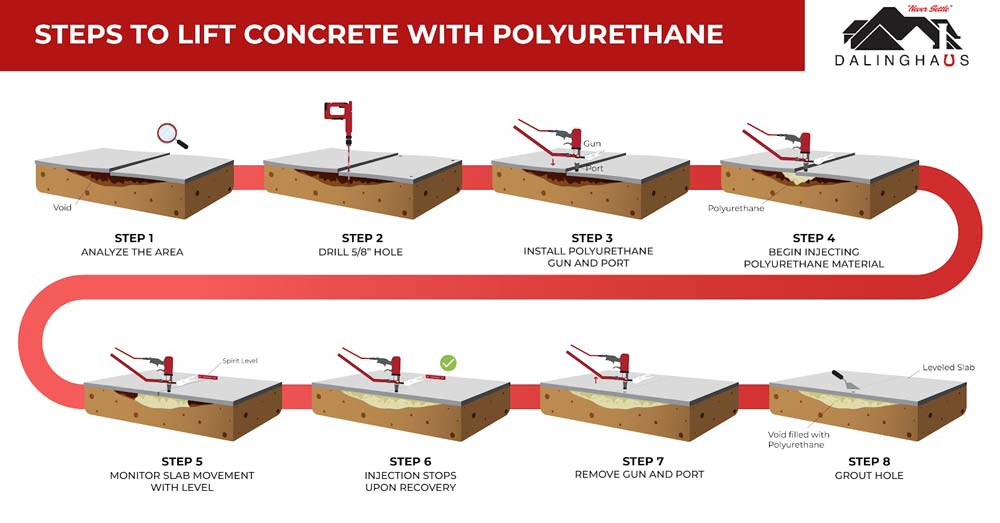
Professional concrete leveling is a fast and effective way to repair a wide range of concrete surfaces, including driveways, sidewalks, patios, pool decks, and garage floors.
Concrete Leveling Vs. Concrete Replacement
The advantage of concrete leveling over concrete replacement is that it’s much more cost-effective, less time-consuming, and causes minimal disruption to the surrounding area. Furthermore, íf using polyurethane foam injection, the process can be completed in just a few hours.
Will Concrete Leveling Work For All Uneven Slabs?
No, if the concrete slab is severely damaged, it must be dug up and replaced.
Is DIY Concrete Leveling A Good Idea?
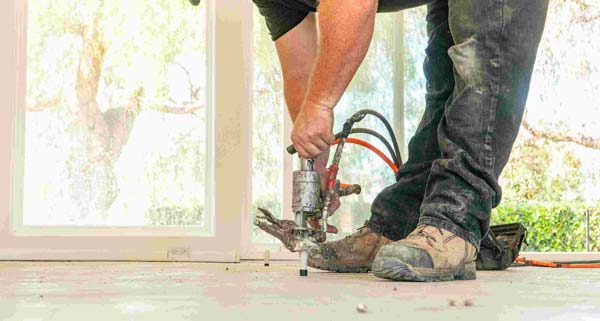
No, DIY concrete leveling isn’t a good idea. It requires training, experience, and specialized equipment, which most people – unless they’ve done concrete leveling professionally – don’t have access to. If you have an uneven concrete slab on your property, contact a professional contractor with the knowledge, experience, and tools necessary to do the job correctly.
How Much Does Concrete Leveling Cost?
On average, the cost of concrete leveling can range (in June 2023) from $1500 to $3,000, although larger projects may cost more. The cost per square foot typically ranges from $6 to $10. However, some contractors may charge a flat rate or an hourly rate for their services, so getting multiple quotes is essential to ensure you’re getting a fair price.
Factors that can affect the cost of concrete leveling include the size of the affected area (because this determines the amount of foam necessary), ease of access, and your geographical location.
Professional concrete leveling is an excellent long-term solution for fixing an uneven slab. However, choosing a reputable and experienced contractor who uses high-quality materials and equipment is essential to ensure the best results.
If you’re thinking about DIY concrete leveling and you’re in Southern California, Arizona, or Nevada, contact us today and schedule an evaluation. We’ll come out, inspect the uneven slab, and give you a professional repair estimate. All our concrete leveling jobs come with a 10 year warranty.







2 Responses
My concrete slab in the garage. Has started to sync Left Right South corner. The slab has not cracked at this point. I believe the soil underneath has been washed out. By groundhogs and winter runoff.
My garage floor need to be leveled towards the rear right and left hand corner it is lifting up in the front. Due to Winter run off and groundhogs digging underneath.